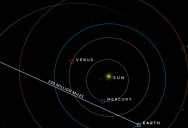NASA Successfully Completed Communications Test With Distant Spacecraft That Achieves Data Transmission Rates 100 Times Faster Than Previously Possible

Fast and accurate communication is something that most people today enjoy and really don’t even have to think much about. When it comes to communicating with spacecraft traveling through our solar system, however, things can get a lot more difficult.
In the past, space agencies have used a variety of different methods of communication including broadcasting radio waves out toward a spacecraft so that it could pick them up and respond.
This is effective, but it takes significant power because the message has to be broadcast out in a relatively broad range so that it is sure to come in contact with the desired spacecraft.
For the Psyche mission, however, NASA has successfully tested something different.
Rather than using broad radio waves, they have opted to use a very precise laser communication system. This allows them to direct a communications laser beam to and from the spacecraft to give instructions and receive data.

The difficulty is that with lasers, you have to be extremely precise. Directing a laser toward a stationary object on Earth comes with its own difficulties, but trying to send a laser millions of miles away to a relatively small spacecraft while both it and the Earth are moving seems almost impossible.
The NASA engineers, however, have achieved this goal.
The Psyche mission is traveling through the inner solar system awaiting the Psyche asteroid to study from 2029-2031. While getting in position, NASA is using the opportunity to test out the laser communications (and other systems), and they have recently completed the most impressive test yet.
On July 29th, they were able to successfully communicate back and forth with laser light while the spacecraft was 460 million kilometers (290 million miles) away from Earth. This is almost the same as the furthest distance that Earth and Mars get from each other, so it is an important proof of concept for future Mars missions.
Meera Srinvasan is the project operations lead at NASA’s Jet Propulsion Laboratory (JPL) in Southern California, and she put out a statement, saying:
“The milestone is significant. Laser communication requires a very high level of precision, and before we launched with Psyche, we didn’t know how much performance degradation we would see at our farthest distances. Now the techniques we use to track and point have been verified, confirming that optical communications can be a robust and transformative way to explore the Solar System.”
While the most impressive thing is that they are able to hit the spacecraft with the laser from such a great distance, it is just as amazing that the quality and speed of the data is still very good.
They were able to send data at a rate of between 6.25 and 8.3 megabits per second. This is a significant reduction from the peak speed on previous tests that were done much closer (53 million kilometers (33 million miles), where they hit 267 megabits per second), but it is still amazing.
Most notably, even at this reduced speed, it is over 100 times faster than using radio waves, meaning the craft will be able to transmit back much larger amounts of data than would previously be possible.
The Psyche craft will now orbit the inner Solar System for several years, completing additional tests, until it reaches asteroid 16 Psyche and begins its orbiting and gathering data for its real mission.

That is a remarkably fast connection!
If you thought that was interesting, you might like to read about why we should be worried about the leak in the bottom of the ocean.

Sign up to get our BEST stories of the week straight to your inbox.




